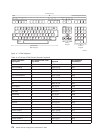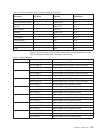
For example, on a British system with a QCHRID of 697 285 (character set 697
code page 285) in message CPX8416 that uses Telnet with CCSID(*BRITISH), the
tables would have the following names:
v Outgoing (EBCDIC-to-ASCII) Q285A06A5V
v Incoming (ASCII-to-EBCDIC) QA5V697285
User-Defined Mapping Tables (ASCII Mode)
Where the multinational or NLS mapping tables do not meet the requirements of a
user, user-defined character mapping tables can be created and used.
You also have the ability to specify user-defined mapping tables using the outgoing
ASCII-to-EBCDIC table (TBLVTOUT) and incoming ASCII-to-EBCDIC table
(TBLVTIN) parameters of the STRTCPTELN command. You can specify a
user-defined mapping table for either the outgoing mapping table or the incoming
mapping table and then use the system default value for the other.
For details on how to create user-defined mapping tables, see Appendix C. Mapping
Tables Associated with TCP/IP Function.
System Functions Available during a Telnet Client Session
This material is covered in the AS/400e Information Center under the TCP/IP
topic. For more information see “TCP/IP Topics in the Information Center” on
page xv.
Print
Press the 5250-mode Print key to start the printing function and produce a printed
copy of the display. Press the Reset key to return to the Telnet session. The Print
key is always processed on the client system, so the spooled file created by the
Print key is placed on the job output queue on the client system. Refer to the
System Operation
book for more information about working with and printing
spooled files.
182 OS/400 TCP/IP Configuration and Reference V4R4
|
|
|


















